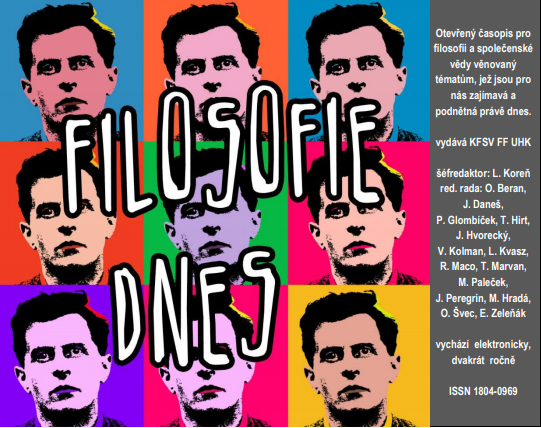K fenomenognozii časového vědomí
DOI:
https://doi.org/10.26806/fd.v8i2.242Abstract
Následující text vydal v roce 1930 Oskar Kraus pod názvem Zur Phänomenognosie des Zeitbewußtseins v časopisu Archiv für die gesamte Psychologie, 75, n. 1-2, s. 1-22. Obsahuje výňatky z korespondence Franze Brentana a pražského profesora Karlo-Ferdinandovy univerzity Antona Martyho z roku 1895 a část Martyho přednášky o Brentanově teorii časového vědomí z téhož roku. Tématem textu je zdůvodnění přechodu od modelu časového vědomí, který pracuje s časovou modifikací předmětů představování, k modelu, který pracuje s časovou modifikací intencionálního vztahu k předmětu. Ve verzi, která je zde zachycena, jde o přechod ke kontinuální modifikaci aktů souzení, které předmět „kladou“. Čtenáře, který by se zajímal o popis a hlubší zdůvodnění vývoje a povahy Brentanových teorií časového vědomí, bych odkázal na následující texty: Chisholm, R. (1981): „Brentano’s Analysis of the Consciousness of Time“. Midwest Studies in Philosophy 6 (1), 3-16, a Chrudzimski, A. (2005): Intentionalität, Zeitbewusstsein und Intersubjektivität, Studien zur Phänomenologie von Brentano bis Ingarden, Ontos, Frankfurt. V češtině pak na Janoušek, H. (2017): „Brentanova teorie času a časového vědomí“. Pro-Fil, 18, no. 1, (v tisku), dostupné online na stránkách časopisu Pro-Fil.
Downloads
Published
Issue
Section
License
Authors who publish in this journal agree that:
1. Authors retain copyright and guarantee the journal the right of first publishing. All published articles are licensed under the Creative Commons Attribution license, which allows others to share this work under condition that its author and first publishing in this journal was acknowledged.
2. Authors may enter into other agreements for non-exclusive dissemination of work in the version in which it was published in the journal (for example, publishing it in a book), but they have to acknowledge its first publication in this journal.
3. Authors are allowed and encouraged to make their work available online (for example, on their websites) as such a practice may lead to productive exchanges of views as well as earlier and higher citations of published work (See The effect of open access).


